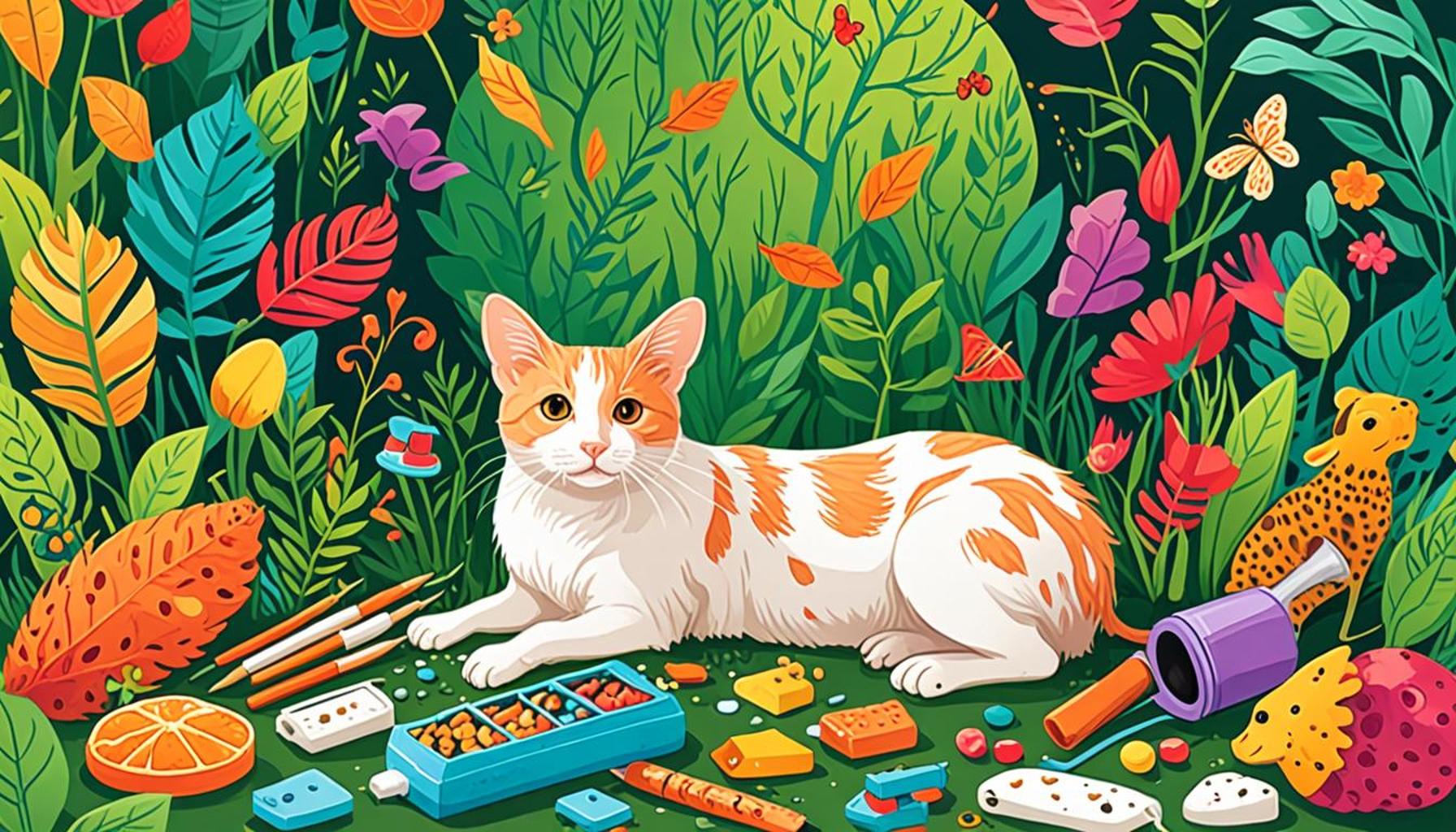The Role of Sensory Enrichment in Reducing Aggressive Behavior in Pets

The Importance of Engaging Pets’ Senses
Many pet owners may overlook the significance of engaging their pets’ senses, often attributing aggressive or restless behavior merely to a lack of training. However, the roots of such issues frequently lie in boredom, stress, or inadequate mental stimulation. Sensory enrichment provides an effective means to address these causes by activating a pet’s senses—sight, sound, smell, and touch. This multifaceted approach not only enhances the pet’s mental well-being but also fosters a more peaceful and harmonious environment at home.
Key Benefits of Sensory Enrichment
- Increased Calmness: Engaging a pet’s senses through various activities can significantly reduce anxiety and mitigate aggressive behaviors. For instance, dogs introduced to novel scents or sounds may become less reactive during stressful situations.
- Enhanced Bonding: Activities that stimulate the senses—such as playing together with textured toys or exploring varied environments—can deepen the emotional connection between pets and their owners. The more time spent engaging in sensory activities, the stronger the bond can grow.
- Improved Behavior: Pets that experience a well-rounded sensory diet are generally calmer and less likely to display unwanted behaviors. For example, cats who engage with interactive play often exhibit fewer signs of aggression toward other pets in the household.
Common Sensory Enrichment Techniques
Pet owners have a variety of techniques available to stimulate their pets’ senses effectively. Some particularly effective methods include:
- Interactive Toys: Find toys designed to challenge a pet mentally while providing tactile stimulation. Puzzle feeders, for example, require pets to solve a problem to access treats, combining the elements of play and mental engagement.
- Natural Scents: Incorporating safe herbs, such as lavender or catnip (for felines), can stimulate the olfactory senses. Many pet shops or local markets sell these herbs, contributing to a serene atmosphere. The calming effects of these scents can be particularly beneficial in a bustling environment like a Nigerian household.
- Exploratory Walks: Regular outings are crucial for enriching your pet’s sensory experiences. Take your dog on varied walking routes each week, exposing them to new sights and sounds. For cats, consider supervised outdoor time. This practice encourages curiosity and exploration, which can lead to a more contented pet.
Exploring these sensory enrichment techniques opens doors to a more tranquil home life. By addressing the diverse sensory needs of pets, owners can not only mitigate aggressive behaviors but also cultivate a happier and more balanced atmosphere for everyone involved. Investing time in sensory engagement with pets enriches their lives while simultaneously improving the overall dynamics within the household. Curious pet owners are encouraged to learn further and discover innovative ways to enhance their pets’ daily experiences.
ADDITIONAL INSIGHTS: Expand your understanding here
Understanding the Link Between Sensory Enrichment and Aggression
To grasp how sensory enrichment can successfully reduce aggressive behavior in pets, it is vital to understand the underlying causes of such behavior. Often, aggression in pets stems from a state of fear, anxiety, or frustration. In a bustling environment like Nigeria, where noise and distractions abound, pets may experience overstimulation, leading to heightened aggression. When pets are deprived of adequate mental and sensory stimulation, they can feel trapped, which exacerbates their anxiety and can prompt aggressive responses.

Many pet owners may not realize how much day-to-day stimuli or the lack thereof can affect their pets. Just as humans thrive on engagement, pets require diverse sensory experiences to remain balanced and content. A well-rounded sensory diet—which comprises various types of stimuli—addresses these needs effectively. For example, the sight of moving objects, the sounds of rustling leaves, and the smell of fresh herbs can create a richer sensory environment that calms nervous energies and redirects focus away from potential triggers of aggression.
The Science of Sensory Input
Research has shown that engaging sensory inputs can lead to significant behavioral adjustments in pets. Dogs, known for their keen sense of smell, benefit immensely from scent-related activities, which can help alleviate signs of stress and agitation. Similarly, studies suggest that cats that engage with a variety of tactile stimuli tend to exhibit fewer aggressive tendencies toward other animals. The reason is simple: active sensory stimulation enhances overall well-being, promoting contentment and ultimately reducing the likelihood of confrontational behavior.
Moreover, sensory enrichment is not just an essential practice for pets but also a crucial part of responsible pet ownership. Engaging in sensory activities is a proactive step that strengthens the relationship between pets and their owners while contributing to a more peaceful household. This is especially relevant in urban Nigerian settings where pets can sometimes be overwhelmed by bustling surroundings, traffic sounds, and piled-up excitement from both people and other animals.
Creating a Sensory-Friendly Environment
Creating an environment rich in sensory opportunities does not require extensive resources. Simple yet effective techniques can enhance your pet’s life while minimizing aggressive behaviors. Here are some practical suggestions:
- Texture-rich Toys: Available in many local pet stores, varied textured toys can offer tactile stimulation that intrigues pets and keeps them engaged.
- Soundscapes: Consider using nature soundscapes, such as rain or ocean waves, to create a calming atmosphere, helping to soothe pets during stressful moments.
- Varied Treats: Treats that differ in flavor and texture can stimulate both taste and smell, giving pets reasons to explore and enjoy their environment.
In summary, understanding the role of sensory enrichment is key to reducing aggression in pets. By fostering an engaging environment that explores their senses, pet owners can not only minimize aggressive behaviors but also promote a happier, healthier pet. The investment in sensory experiences is an investment in the overall harmony of your home, making it a win-win situation for both pets and their owners.
The Role of Sensory Enrichment in Reducing Aggressive Behavior in Pets
Many pet owners are often bewildered by their animal’s aggressive behavior, seeking solutions that can alleviate the situation. Sensory enrichment not only provides mental stimulation for pets but also serves as an important measure to reduce potential aggression. This article explores various sensory enrichment strategies and their effectiveness in creating a harmonious living environment for both pets and their owners.
Understanding Sensory Enrichment
Sensory enrichment refers to the enhancement of sensory experiences through various stimuli such as sounds, smells, and tactile interactions. It is a crucial component in animal care as it engages a pet’s senses, ultimately leading to reduced stress and aggression. Studies show that pets regularly exposed to diverse sensory inputs exhibit lower levels of anxiety and behave more positively in social interactions.
Benefits of Sensory-Driven Enrichment
The integration of sensory enrichment into a pet’s daily routine offers an array of benefits:
| Category | Key Features |
|---|---|
| Visual Stimulation | Bright colors and moving objects can capture a pet’s attention. |
| Olfactory Interaction | Introducing various scents can help reduce anxiety and encourage natural behaviors. |
Furthermore, incorporating tactile experiences, such as different textures and surfaces, enhances their exploration instincts, allowing for a more well-rounded behavioral profile. Pets that receive this kind of stimulation are typically more balanced and less prone to exhibiting signs of aggression.
The investment in sensory enrichment strategies is evident in pet behavior management, showing that integrating play, exploration, and interaction through sensory experiences is not just beneficial but essential in promoting healthier, less aggressive pets. Ultimately, by prioritizing these activities, owners may foster deeper bonds with their pets, leading to improved overall wellbeing.
ADDITIONAL INSIGHTS: Expand your understanding here
Implementing Sensory Enrichment Strategies
While the necessity of sensory enrichment in promoting better behavior in pets is established, knowing how to effectively implement these strategies is crucial. Careful planning and tailored approaches to sensory experiences can vastly improve the emotional states of pets, thus reducing the likelihood of aggression. In populous regions like Lagos, local pet owners can easily adopt methods suitable for their environment. Here are some practices pet parents can explore:
Utilizing Natural Elements
Integrating natural elements into your pet’s environment can greatly enrich their sensory experience. For instance, creating a small indoor garden with pet-safe plants, like catnip for cats or basil for dogs, engages their sense of smell and taste while also providing visual interest. The act of exploring and interacting with these plants can distract pets from stressors that might lead to aggressive behavior.
Outdoor activities are equally vital. Regular visits to parks or green spaces allow pets to experience varied textures underfoot, fresh air, and the sounds of nature, all of which contribute to a calming atmosphere. Moreover, if you live in an urban area where such spaces may be limited, consider a simple trip to a pet-friendly venue or even create an improvised outdoor experience in your backyard.
Interactive Play and Training
Engagement through play is a key aspect of sensory enrichment. Interactive toys, such as puzzle feeders or toys that dispense treats, can provide mental stimulation that keeps pets occupied and satisfied. This is particularly relevant for breeds known for high energy, like the Nigerian indigenous dog breeds, which often thrive on physical activities that challenge both their bodies and minds.
Training sessions that incorporate scent detection or agility exercises can also be incredibly beneficial. Such activities not only improve behavior but strengthen the bond between pets and their owners. Importantly, these sessions provide a constructive outlet for excess energy that, if left unchecked, may lead to frustration and potential aggression.
The Benefits of Routine and Consistency
Establishing a consistent routine that integrates sensory enrichment activities can significantly influence your pet’s demeanor. When pets anticipate daily interactions—whether it’s scheduled playtime, training sessions, or sensory exploration—they may feel more secure, thus mitigating anxiety levels. In Nigeria, where traditional pet training techniques can sometimes vary widely, sticking to a dedicated schedule ensures that the animals understand what to expect and when.
Additionally, the inclusion of sensory-related activities in a pet’s daily life can aid in minimizing disruptions. For example, during festive occasions like traditional Yoruba festivals or during times of significant street noise, such as during New Year celebrations, engaging pets in sensory games can distract them from overwhelming stimuli and prevent aggressive outbursts.
Community and Social Exposure
Another dimension of sensory enrichment involves social interaction with other animals and people. Regular socialization can help pets develop better coping skills, and is particularly essential for young or timid pets that may struggle with overreactions to unfamiliar experiences. Dog parks or pet-friendly cafes can offer socialization opportunities in safe environments. Moreover, collaborative strategies with neighbors or local pet groups can facilitate shared knowledge on sensory enrichment, providing a network of support and resources.
By employing these various strategies, pet owners can cultivate a nurturing environment that not only addresses aggressive behaviors effectively but fosters emotional stability and happiness in pets. As urban life continues to present challenges for pet owners, embracing these sensory enrichment techniques can significantly enhance the overall quality of life for pets while safeguarding their well-being in fast-paced environments.
RECOMMENDED: Check out this similar article
Conclusion
In summation, the role of sensory enrichment in addressing and reducing aggressive behavior in pets cannot be overstated. By fostering environments that cater to a pet’s natural instincts and senses, owners can not only diminish their pets’ anxiety but also cultivate a sense of well-being. As we have explored various approaches— from integrating natural elements to fostering interactive play and consistent routines— it is clear that a multifaceted strategy yields the best outcomes for pet behavior.
Moreover, fostering community interactions through socialization plays a pivotal role in creating a well-rounded and emotionally stable pet. For pet owners in Nigeria, where the challenges of urban living can often stress our beloved companions, leveraging local resources and community knowledge in sensory enrichment can be particularly beneficial. Increased engagement, whether with humans or other pets, builds resilience against potential triggers for aggression, leading to more harmonious living situations.
Finally, it’s essential to remember that each pet is unique, and tailoring sensory enrichment activities to their specific needs and preferences is key. Engaging in these practices not only contributes to a positive behavioral transformation but also deepens the bond between pets and their owners. Therefore, we invite pet parents to take action, explore sensory enrichment opportunities, and witness the profound impact this can have on their pets’ happiness and temperament. Investing in your pet’s sensory experiences today is an investment in a more peaceful tomorrow.



